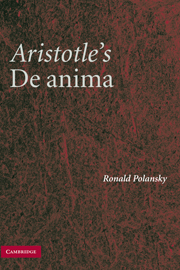Book contents
- Frontmatter
- Contents
- Preface
- List of Abbreviations
- Introduction
- COMMENTARY ON DE ANIMA: : Book 1
- 1 The Nobility and Difficulty of Study of Soul; Its Connection with Body
- 2 The Predecessors' Use of Soul to Account for Motion and Perception
- 3 Criticism of Predecessors' Way of Accounting for Motion
- 4 Criticism of the Harmonia View as an Account of Motion
- 5 Criticism of Predecessors' Way of Accounting for Cognition
- COMMENTARY ON DE ANIMA: Book 2
- COMMENTARY ON DE ANIMA: Book 3
- Bibliography
- Index
4 - Criticism of the Harmonia View as an Account of Motion
Published online by Cambridge University Press: 18 December 2009
- Frontmatter
- Contents
- Preface
- List of Abbreviations
- Introduction
- COMMENTARY ON DE ANIMA: : Book 1
- 1 The Nobility and Difficulty of Study of Soul; Its Connection with Body
- 2 The Predecessors' Use of Soul to Account for Motion and Perception
- 3 Criticism of Predecessors' Way of Accounting for Motion
- 4 Criticism of the Harmonia View as an Account of Motion
- 5 Criticism of Predecessors' Way of Accounting for Cognition
- COMMENTARY ON DE ANIMA: Book 2
- COMMENTARY ON DE ANIMA: Book 3
- Bibliography
- Index
Summary
In arguing that it is impossible for the soul to be in motion (see 406a2–3), Aristotle has criticized those predecessors conceiving the soul as a magnitude itself in motion thereby moving the body. Chapter 4 continues the criticisms with regard to a theory that might be supposed very close to Aristotle's own. The view of the soul as a harmonia (ἁρμονία), attunement, or concord of the body may advance beyond the crude mobile soul, for example, the Democritean spherical soul atoms or the Platonic world soul moving the heavens by way of its rotational motion. A harmonia is not itself in motion and will not travel from instrument to instrument, as soul transmigrating to any chance body (see 407b20–23). The harmonia view connects soul closely with body without making soul a magnitude like body. Soul rather serves as proper attunement, synthesis, or ratio of the various contraries that compose the body. Since right above in 407b23–24 Aristotle suggested that the soul might be the form of the body, and form could be some sort of synthesis or ratio (logos) of the body, harmonia could be the body's form and converge with Aristotle's own view. He must distinguish this view from his own.
The attack on the harmonia view constitutes a crucial part of the overall argument. Aristotle's previous rejection of the soul as a magnitude in motion, that is, a substantial bodily being in rectilinear or circular locomotion, leaves open the possibility that the soul might instead be an attribute or accident of the body, much as color or three cubits (cf. 406a16–22).
- Type
- Chapter
- Information
- Aristotle's De AnimaA Critical Commentary, pp. 103 - 122Publisher: Cambridge University PressPrint publication year: 2007



